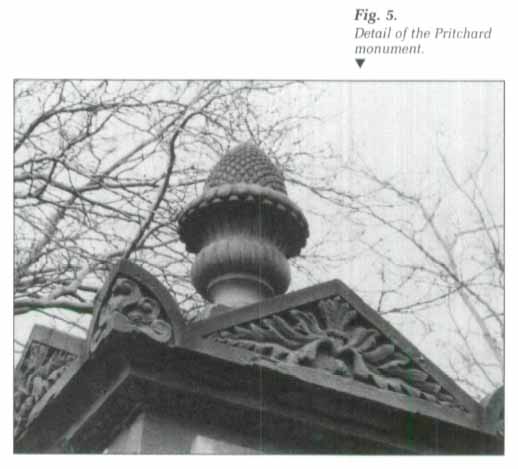Articles
Monuments in the Nineteenth-Century Public Cemeteries of Victoria, British Columbia
Résumé
Cet article traite des différents styles de pierres tombales que l'on trouve à Victoria, en Colombie-Britannique. À partir d'une analyse des monuments funéraires de deux cimetières du ⅪⅩe siècle, l'auteur fait un rapprochement entre l'évolution de l'industrie des pierres tombales et celle du développement urbain de Victoria. Procédant comme en histoire de l'art, il cherche à caractériser le style architectural et artistique de cet élément important de la culture matérielle victorienne. D'autres études avaient été faites sur les cimetières de Colombie-Britannique, mais elles se limitaient principalement aux aspects généalogiques, socio-historiques, technologiques et géographiques. L'auteur souligne le regain d'intérêt que suscitent les cimetières et soutient que les pierres tombales devraient avoir leur place dans l'histoire de l'art et de l'architecture du Canada au même titre que les autres œuvres d'art.
Abstract
This article examines the stylistic trends of grave memorials in Victoria, British Columbia. Based on an analysis of extant monuments in two nineteenth-century cemeteries, the development of the monument industry is discussed in relation to the urban history of Victoria. Employing an art historical analysis, the author traces the architectural and artistic style of this important category of Victorian material culture. Previous examinations of cemeteries in British Columbia have been limited primarily to genealogical, social historical, technological and geographic studies. The author notes the increase in awareness and interest in cemetery studies and argues that the grave monument should also be recognized simply as a work of art, thereby assuming its place in Canadian artistic and architectural history.
Introduction
1 If the history of art can be seen as a series of revivals of the classical tradition, the Victorian era is certainly no exception, although in addition to the classicism of Greek and Roman antiquity, Victorian artists and artisans expressed interests in elements from other artistic traditions as well. While the most well known of these is the Gothic Revival, there were also revivals of ancient Egyptian, Renaissance and rococo forms. Heavily influenced by the Picturesque movement, artists also explored the use of natural forms to produce elaborate decoration. Towards the latter part of the nineteenth century, these different styles and interests were often amalgamated within a single context to create a cohesive, purely "Victorian" style. This Victorian historicism is perhaps most evident in our surviving nineteenth-century buildings, yet we have a second valuable source for the study of the history of architectural and artistic style in our surviving nineteenth-century cemeteries.1
2 In Victoria, British Columbia, two nineteenth-century public cemeteries survive. The first cemetery in Victoria, now lost to urban development, was opened in 1843 and functioned primarily as a burial-ground for employees stationed at the Hudson's Bay Company fort. With the 1858 gold rush, Victoria's population expanded dramatically almost overnight, and the authorities, concerned about public health and anxious to sell the land around the fort, moved the cemetery to a more rural location on church reserve land on Quadra Street. This cemetery, now known as Pioneer Square, was immediately unpopular primarily because it did not conform to the Picturesque ideals of the rural cemetery movement.2 It was finally closed in 1873 with the opening of the much larger, carefully landscaped Ross Bay Cemetery.
3 Based on an analysis of extant monuments in these two cemeteries, this paper will examine the stylistic trends of grave memorials in Victoria in the nineteenth century and comment on the development of the monument industry as it relates to the history of the city. The intention of this project was to provide a general art historical analysis of the monuments in Victoria's two surviving nineteenth-century public cemeteries. Previous examinations of cemeteries in British Columbia have been limited primarily to genealogical, social historical, technological and geographic studies. The author hopes that with the increase in awareness of and interest in cemetery studies, in addition to the types of recognition dictated by other disciplines, the grave monument will also be recognized simply as a work of art and its place in Canadian artistic and architectural history will be explored. This paper represents a preliminary effort in that direction.
4 In preparation for this paper, an archival search for primary and secondary sources was done to provide a historical framework for the study of both Pioneer Square and Ross Bay Cemetery. For Pioneer Square, a description for each monument was then completed and analyzed to determine groupings in form, style and medium. This was also done for four of the ten original blocks or sections at Ross Bay. Photographs were then taken of individual monuments illustrating significant trends, and a more specific stylistic analysis was done, comparing form and detailing with other examples contemporary with the monuments, both local and distant, from architecture and the minor arts.
Monuments of Pioneer Square
5 There are 113 monuments in Pioneer Square. These can be divided into five basic classifications: ledger stones, benches and tables, obelisks, tablets and architectural monuments. Some of these forms are derived from historic sources. For example, the bench and table monuments, with classical pediment mouldings, supportive columns or pilasters, and marble panelling, are reminiscent of classical sarcophagi. The obelisks belong to the category of Egyptian Revival, which was used in funerary structures in England as early as 1837 with the mausoleum of Andrew Ducrow in London's Kensal Green Cemetery. Apparently, the Egyptian Revival was associated with Freemasonry in Europe.3 At least three of the nine Pioneer Square obelisks have low-relief carvings of Masonic symbols.
6 One of the two architectural monuments in the cemetery, the Carrol memorial (fig. 1), is in the Gothic Revival tradition and probably dates to the mid-1860s. It has Gothic tracery, attached pointed arches and fluted columns, and sculpted cherubs' heads and is based on the famous canopy designs like the 1863-1872 Albert Memorial in London by Sir George Gilbert Scott and Edinburgh's 1840 Memorial to Sir Walter Scott designed by the Scottish architect George Miekle Kemp. The Carrol monument is obviously a scaled-down, provincial version. First of all, it is not a canopy, although it is based on the canopy design. Although small, it still represents an awareness of Gothic form as well as an acquaintance with contemporary taste, especially when one considers that it was probably done around the same time as the construction of the Albert Memorial.
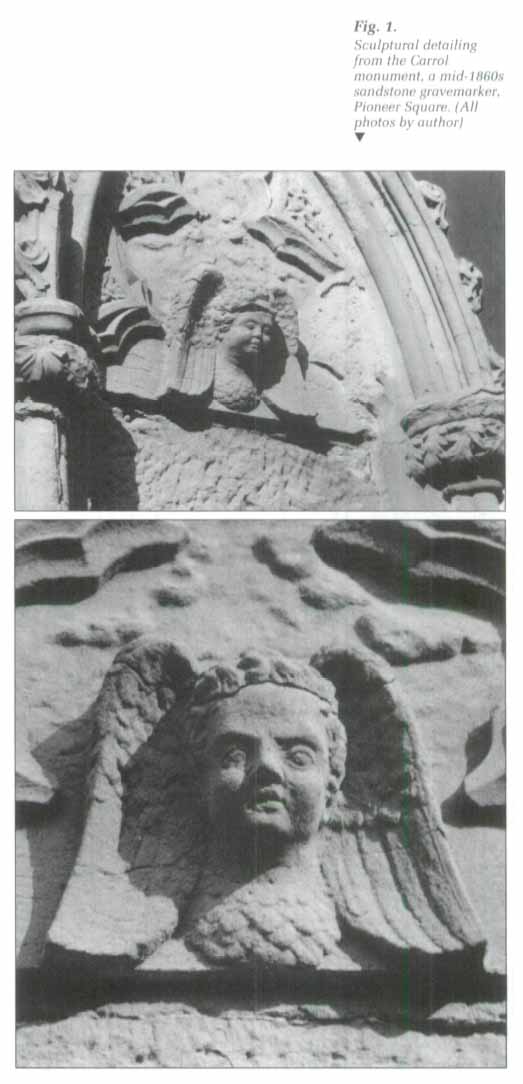 Display large image of Figure 1
Display large image of Figure 1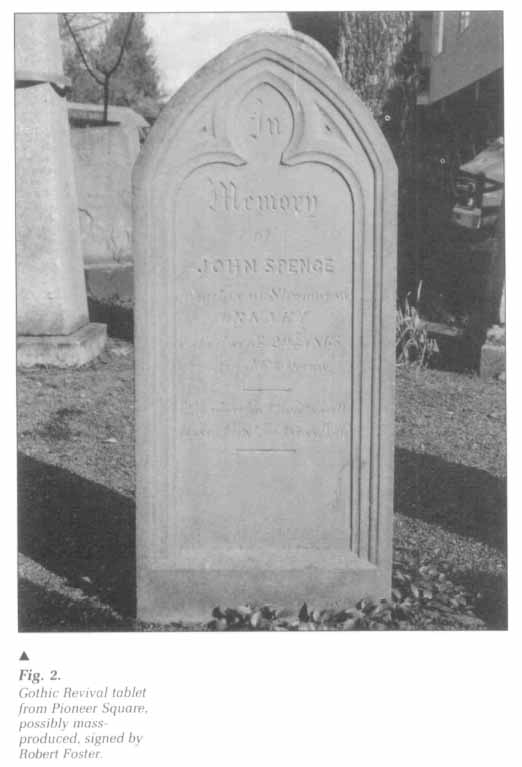 Display large image of Figure 2
Display large image of Figure 2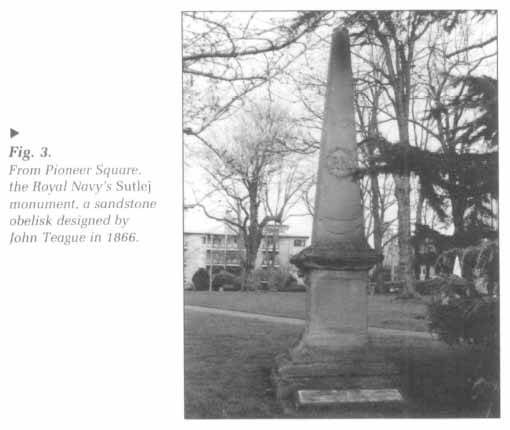 Display large image of Figure 3
Display large image of Figure 37 With a number of varieties in both basic form and sculptural and architectural detailing, the most diverse category in the cemetery is the tablet. While most are done in sandstone, there are a few marble examples as well, and while most are unsigned, there are also some signed stones. Only two signatures are evident in Pioneer Square: Foster and Kirsop. Robert Foster was a native of Yorkshire who ran his stonecutting and building business out of Victoria's Point Ellice neighbourhood.4 The majority of signed pieces are by Foster, the earliest dating to 1864. George Kirsop was born in Newcastle-on-Tyne in England5 and was working in Pioneer Square as early as 1871.
8 There are indications that some of the tablets were either mass-produced, possibly imported from larger urban centres like San Francisco, or at least prepared from pattern books. There are, for example, two sandstone tablets by Foster, one dating from July 1864 and the other from September 1865 (fig. 2) that are exactly the same except for the epitaph. Both have tops shaped in a pointed arch with simple low-relief Gothic tracery on the front surface. They are exact in terms of design, finish, size and scale. There are other examples as well, including two scroll-faced markers and two tablets with rounded tops and sculpted cords following the top curve.
9 In addition to the two known stonemasons, the other names associated with monument making in Pioneer Square include those of the architects Thomas Trounce and John Teague. Teague designed the 1866 sandstone obelisk memorial (fig. 3) for the officers and men of the HMS Sutleg who died while stationed at Esquimalt. Trounce designed the large and impressive 1872 Pritchard monument (figs. 4 and 5).
10 The Pritchard memorial, described by the British Colonist as excelling "anything before produced in the province,"6 embodies at least two influences evident in the Victorian era. Its classicism, manifested in its use of Italian marble panels, pediments and restrained lines, is combined with naturally derived decorative motifs. An area around the base of the monument is included for a garden. The mouldings and general design are classically influenced, yet there is a low-relief thistle motif in the top pediment and the bottom pediment has foliage detailing. This interplay between the carved foliage and the natural leaf of the garden at the base is a clever and subtle touch on behalf of the architect and is derived from a love for natural form inspired by the Picturesque.
11 In this monument we see an illustration of the coexistence of different styles in a single context. Picturesque naturalism is used in a monument of classically influenced design. Prior to about 1870, the historic styles in Pioneer Square tend to be used by themselves. That is to say, styles are not usually combined in the main body of the design. A Gothic Revival monument, such as the Carrol memorial, is primarily the Victorian vision of what the Gothic style should look like. After 1870, the combination of styles, as exemplified in the Pritchard monument, becomes more prevalent.
Monuments of Ross Bay Cemetery
12 When initially confronted with the task, it seems unfair to compare the gravestones of the Ross Bay Cemetery with those from Pioneer Square. In terms of numbers alone, a few hundred against thirty-five thousand, the growth of Victoria in the post-1873 era becomes self-evident. With population growth and urbanization came increases in technology and trade. These changes had a direct effect on grave monuments. For example, while we have only two names of monument makers from the Quadra Street cemetery, both of whom worked out of Victoria, at Ross Bay we have thirteen from Victoria and another nine from as far away as San Francisco, Ottawa and London, England.7 Yet, although we have greater variation at Ross Bay, much of the work there still lies within the Victorian era and tradition and adheres to the same basic themes seen in Pioneer Square: historicism reflected through the revival of classical, Gothic, Renaissance and Egyptian styles and an interest in natural motifs ultimately encouraged by the Picturesque tradition as outlined by such English thinkers as John Ruskin.
13 Many of these new monument makers began work in Victoria in the 1880s, a period of enormous economic growth for the city. Victoria's population increased by 184 per cent over the decade. Its physical size doubled and its exports increased by one-third.8 Much of this is probably due to the city's perception of itself in the 1870s. It was thought that it would become the capital of the province, the terminus of the Canadian Pacific Railway and the greatest port north of San Francisco.9 With Vancouver's designation as the CPR's terminus in 1886 and its resulting dramatic growth, the 1890s was not as optimistic a decade for Victoria, although, buoyed by its maritime and shipping industries as well as the island's expanding coal and lumber industries, it continued to grow slowly. Also during the 1890s, the provincial government reaffirmed its position as provincial capital with the construction of the new Parliament Buildings. In general, Victoria was enjoying a construction boom accompanied by significant internal improvements in the water, sewage and road systems.10
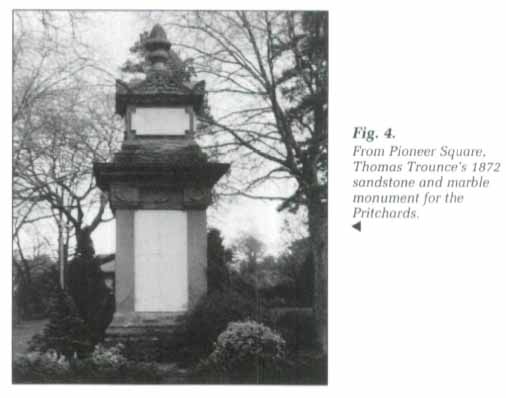 Display large image of Figure 4
Display large image of Figure 414 A period of economic activity and wealth favours patronage in the arts. This is certainly true of the Victoria of the 1880s and 1890s and is probably best reflected in the architecture of the era: Rattenbury's Parliament Buildings and much of the Old Town core were constructed between 1880 and 1900. The same basic concept is reflected in the grave monuments at Ross Bay as well. Most often, the monuments at Ross Bay are larger, more elaborate and less provincial. This is due to a number of factors. First, and perhaps most importantly, the conventions of Victorian art and architecture were established in the first part of the century. By the last two decades of the nineteenth century, a formal vocabulary was well developed and widely accepted. The status quo, both artistic and commercial, advocated strict adherence to it, and it was easily repeated, leading to greater conventionalization. This same process was a significant cause of the modernist rebellion against historicism in Europe, which was beginning to surface about this time. In Victoria, the growing shipping industry and the opening of the Canadian Pacific Railway allowed for the importation of goods from larger urban centres and thus the city was less isolated, both sociopolitically and culturally. With greater urbanization comes greater specialization. Victoria, the tenth largest city in Canada in 1891, developed a larger homegrown monument industry after the opening of Ross Bay. As well, the economic wealth and technological growth in both transportation and materials created cheaper products and a larger class able to afford more permanent monuments.11
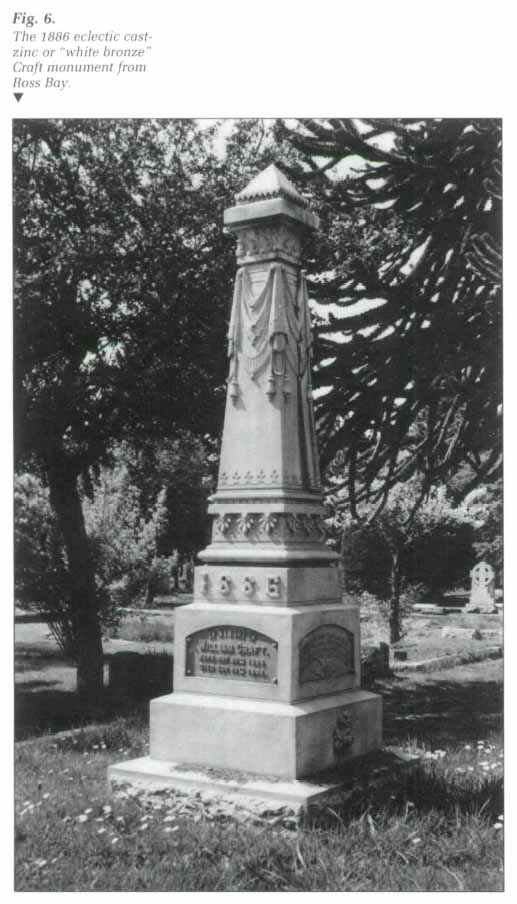 Display large image of Figure 6
Display large image of Figure 615 The technological innovations are best exemplified by cast-iron and cast-zinc monuments mass-produced in foundries. Particularly the zinc gravemarkers, often produced by the White Bronze Company of St. Thomas, Ontario, and then shipped west, were intended to imitate stone at a cheaper price. A distinctive bluish-grey colour was achieved through oxidation and a rough stone-like surface through sandblasting. They were cast in sections and then assembled with individualized inscriptions. Again, these markers conform to previously established Victorian form and are often in the shape of obelisks.12
16 Many of these cast-zinc works thus belong to the larger category of Egyptian Revival monuments, best exemplified, of course, by the obelisk. At Ross Bay, the variation in materials and a new experimentation combining forms from different historic styles within one monument becomes evident as a primary interest. While this eclecticism can be seen in the Quadra Street cemetery, it is not as sweeping a concern as in its later counterpart. For example, the 1886 Craft monument (fig. 6) is a white bronze obelisk with classical detailing. It has a column-like capital, a pedimental base and the shaft is partly shrouded in drapery. Various parts have bands of vegetal patterning and even the monument's date is done in numbers of intertwined leaves.
17 References to classical art are dominant at Ross Bay. Another extremely popular motif was the classical column, more often than not supporting an urn. An excellent example of this category is the Williams monument dating to around 1883 (fig. 7). The monument consists of four columns supporting a classical pediment and a draped urn. Done in white marble, the columns have strange capitals with out-turned acanthus leaves, perhaps again displaying the High Victorian concern for natural or organic ornament. There are variations on this, usually with different numbers of columns—the most popular being the single column. Red granite is another popular medium as well.
18 The neoclassicism also occasionally includes classical revival statuary, as seen in the two fine white marble examples, possibly catalogue-ordered, from the studio of George Kirsop: the Deans monument from around 1879 and the Wood monument (fig. 8) dating to 1887. Both of these consist of single female figures draped in toga-like garments mounted on classical pedestals. The Wood figure leans against an urn and holds a wreath and the Deans figure holds a scroll and, reflecting regional interests, leans against an anchor.
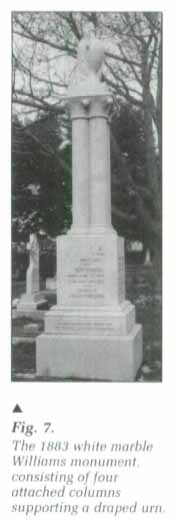 Display large image of Figure 7
Display large image of Figure 7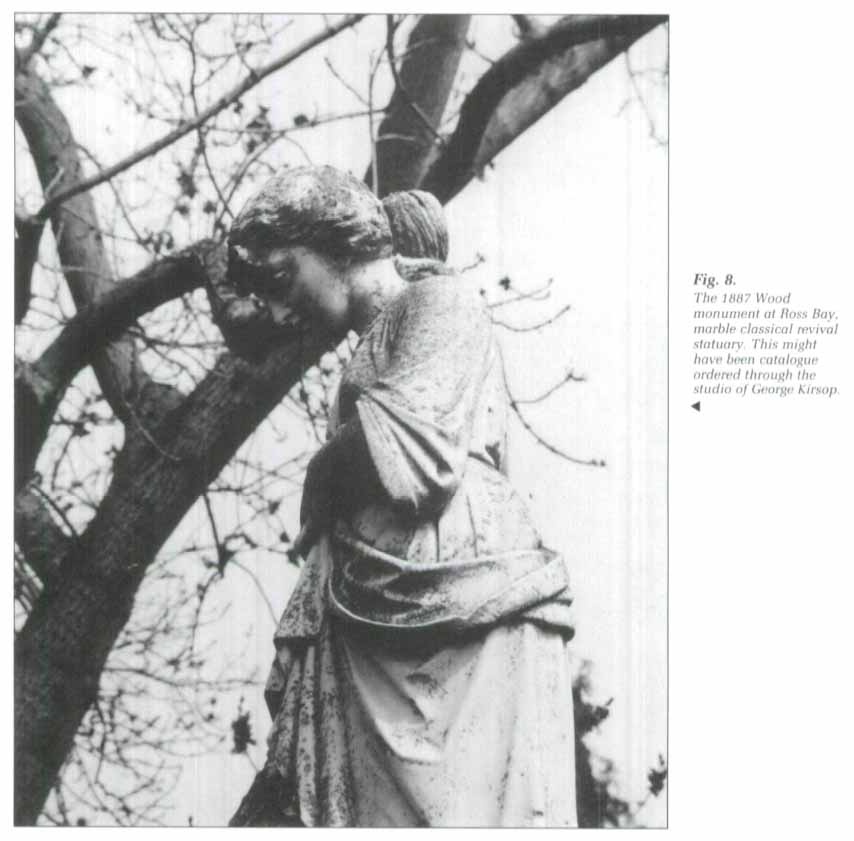 Display large image of Figure 8
Display large image of Figure 819 A third example of the Victorian neoclassic movement can be seen in the numerous classical pedestals, which often support urns as well. Although lacking the same attention to detail, these are similar in shape and general design to Pioneer Square's Pritchard monument. This is evident in, for example, the red granite Porter gravestone from around 1895.
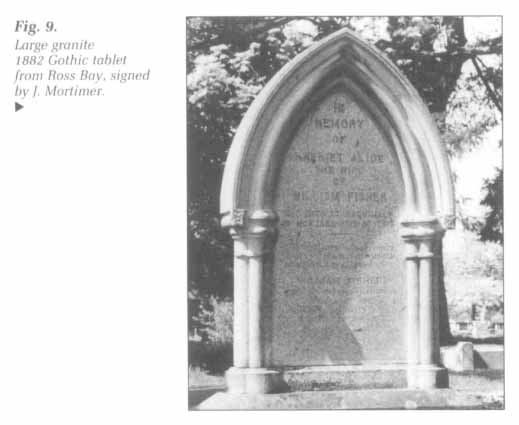 Display large image of Figure 9
Display large image of Figure 9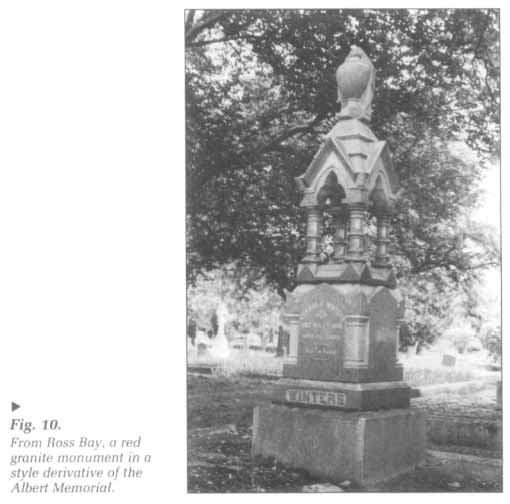 Display large image of Figure 10
Display large image of Figure 1020 The interest in the medieval, an element inherited from the eighteenth-century Picturesque movement and best displayed in the Gothic Revival, led to an increase in the use of the Celtic cross. The surfaces of these are often covered in the Celtic patterns best remembered from early medieval manuscript illumination. They are also sometimes covered in low-relief floral and vegetal forms, derived from the Picturesque and purely Victorian in its use here.
21 The Gothic Revival continued to be an important style of gravestone at Ross Bay. A good example of this, similar to Foster's Gothic tablets at Pioneer Square, is a large granite tablet signed by John Mortimer and consisting of a pointed arch supported on either side by attached fluted columns. This large work was commissioned by the Fisher family in 1882 (fig. 9).
22 The Gothic Revival style was not exempt from classicizing. Simplified versions of the Albert Memorial (fig. 10), devoid of all Gothic detail work, were obviously reproduced from pattern books. They conform strictly to Victorian conventions, are found in a selection of materials such as both granite and red granite and are usually topped by a draped urn. The smooth surfaces, lack of tracery, and classical pediments again refer to the eclectic trends of the late nineteenth-century High Victorian style.
Conclusion
23 What becomes increasingly evident in examining the grave art of Victoria's nineteenth-century public cemeteries is the move towards a greater sense of eclecticism later in the century. The examples presented in this paper clearly exhibit the Victorian's increased willingness to combine historic styles outside of a historical context after around 1870. Combined with this is the repeated use of organic patterning derived from natural vegetal and floral forms. This is a legacy of the Picturesque, but is used in a way that displays the Victorian era's concern for ornamentation. The use of floral elements within the context of grave architecture, yet separate from the monument itself, can be seen in the wrought iron fences that often surround grave plots. While contemporary photographs and descriptions of earlier cemeteries refer to the use of wood picket fencing, the High Victorian sense of ornamentation and use of alternative materials encouraged the popularity of the more ornate metal fences at Ross Bay.
24 The relative size of the monuments is also noticeable. On average, the monuments are much larger than those still standing at Pioneer Square. This is probably due to the combination of a wealthier and larger middle class, cheaper transportation, increased technology and cheaper materials. There is also a greater use of free-standing pieces such as columns, pedestals and obelisks, perhaps indicating in part a preference for styles derived from classical antiquity.
25 The larger monuments in both cemeteries undoubtedly reflect the tastes and aspirations of Victoria's upper middle class. The examples given in this paper, particularly from Ross Bay, tend to be within this more elaborate category, and yet, Ross Bay, like Pioneer Square, contains a vast group of tablets that, while reflecting the same basic trends and styles, are much less lavish in detailing. Proper burial and memorial was a concern for all nineteenth-century classes, and since the monuments seem to have generally been mass-produced or designed through the use of pattern books, the difference in the monuments chosen by those of different socioeconomic status was one of scale rather than of style. Of course, there are a few exceptions to this. The Masons show a preference for obelisks, and different cultural groups, such as the Chinese, Japanese and native Indians, chose monuments that varied in style and specific iconography.
26 Another characteristic to consider at Ross Bay is the prevalence of signed monuments. There are no signed extant grave memorials before 1864 in Victoria. This, of course, might simply be due to loss through time, although it could also be explained by the development of a formal monument industry sometime after 1864. We have the names of twenty-two monument makers from Ross Bay Cemetery and only two from Pioneer Square. The only published or known example of an architect's involvement at Ross Bay is Samuel Maclure's 1915 mausoleum design for W.M. Agnew." Both Thomas Trounce and John Teague created monument designs for patrons at Pioneer Square. Victoria's earliest artisan associated with grave art, Robert Foster, is identified in the city directory as a stone cutter and builder, not a monument maker. This would seem to indicate an initial void in monument designers, at first filled by local architects and then later by local and distant professionals. This also corresponds to the historical development of the city of Victoria and would account for the greater repetition of designs and conventions at Ross Bay, where artisans and masons more often worked from catalogues and pattern books or patrons imported mass-produced monuments.
